by Janelle Valore
One of the leading causes of death in children under the age of 14 in the United States are injuries caused during an automobile accident or crash. If used properly, child safety seats and seatbelts can significantly reduce the chance of injury. When it comes to transitioning children to booster seats, many parents may be quick to transition due to the ease of using a booster seat compared to a car seat. A great resource for parents when deciding whether to transition their child to a booster seat is the car seat or booster seat manual. Before transitioning to a booster seat, most children are in convertible seats, which can accommodate up to 65 pounds. Due to car seat manufacturers’ varying requirements, the child must meet the maximum height or weight requirements for their car seat before transitioning to a booster seat. No child should be introduced to a booster seat unless their height or weight limits have been reached in the current car seat.
When comparing the difference between a car seat and a booster seat, the most significant difference is the belt mechanism used to restrain the child. For example, car seats are equipped with a 5-point harness. The 5-point harness has a clip that is positioned flush across the child’s chest, level with their armpits, and a buckle in-between their legs. This type of belt is the safest restraint for children. On the other hand, with a booster seat, the child sits on the booster and uses the car’s safety belt. If the child meets the requirements to use the booster seat, the car’s safety belt should fit properly across his or her shoulder and lap. If a child does not meet the height and weight requirements for the booster seat, the shoulder and lap belt will not fit properly, which increases the chance of injury if a vehicle accident were to occur.
Over the past few years, manufacturers have introduced harnesses to booster seats, which allow more options for the growing child. Rather than prematurely jumping from a convertible seat to a booster seat, these harness booster seats provide the use of the 5-point harness until height and weight limits are reached. Then children can transition to the high back booster seat and eventually to the booster seat. The high back booster seat still provides all of the head and back safety of a car seat but allows the car’s seat belt to be used. A high-back booster is a good option for providing an additional layer of protection for those not quite ready to transition to a booster seat. Another safety feature of the harness to a booster seat is that the seat uses a car’s LATCH system, which provides a more secure installation in the vehicle.
Height and weight, while extremely important, are not the only factors that should be considered when deciding if a child is ready to transition to a booster seat. A child’s maturity also plays a role in whether or not a booster seat is appropriate. For example, if a child cannot sit for an extended period without slouching, pulling the seatbelt and moving around in the seat, a booster seat is not the safest seat choice for that child.
After reviewing the car seat manufacturer’s height and weight requirements and assessing your child’s maturity, you should have enough information to appropriately determine whether or not your child is ready for a booster seat.








Leave A Comment